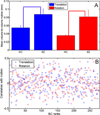Nodal centrality of functional network in the differentiation of schizophrenia
- PMID: 26299706
- PMCID: PMC4591247
- DOI: 10.1016/j.schres.2015.08.011
Nodal centrality of functional network in the differentiation of schizophrenia
Abstract
A disturbance in the integration of information during mental processing has been implicated in schizophrenia, possibly due to faulty communication within and between brain regions. Graph theoretic measures allow quantification of functional brain networks. Functional networks are derived from correlations between time courses of brain regions. Group differences between SZ and control groups have been reported for functional network properties, but the potential of such measures to classify individual cases has been little explored. We tested whether the network measure of betweenness centrality could classify persons with schizophrenia and normal controls. Functional networks were constructed for 19 schizophrenic patients and 29 non-psychiatric controls based on resting state functional MRI scans. The betweenness centrality of each node, or fraction of shortest-paths that pass through it, was calculated in order to characterize the centrality of the different regions. The nodes with high betweenness centrality agreed well with hub nodes reported in previous studies of structural and functional networks. Using a linear support vector machine algorithm, the schizophrenia group was differentiated from non-psychiatric controls using the ten nodes with the highest betweenness centrality. The classification accuracy was around 80%, and stable against connectivity thresholding. Better performance was achieved when using the ranks as feature space as opposed to the actual values of betweenness centrality. Overall, our findings suggest that changes in functional hubs are associated with schizophrenia, reflecting a variation of the underlying functional network and neuronal communications. In addition, a specific network property, betweenness centrality, can classify persons with SZ with a high level of accuracy.
Keywords: Betweenness centrality; Functional network; Machine learning; Resting state fMRI; Schizophrenia; Support vector machine.
Copyright © 2015 Elsevier B.V. All rights reserved.
Conflict of interest statement
Conflict of interests
All other authors declare that they have no conflicts of interest.
Figures







References
-
- Biswal B, Yetkin F, Haughton V, Hyde J. Functional connectivity in the motor cortex of resting human brain using echo-planar MRI. Magn Reson Med. 1995;34:537–541. - PubMed
Publication types
MeSH terms
Substances
Grants and funding
LinkOut - more resources
Full Text Sources
Other Literature Sources
Medical

